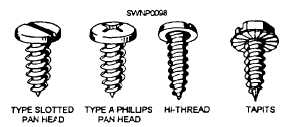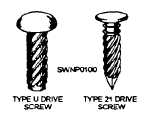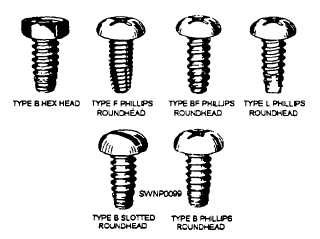Torch brazing and soldering are discussed in Steelworker, volume 1, chapter 6. This section deals only with joining sheet-metal seams by either metal screws or rivets.
METAL SCREWS
Different types of metal screws are available for sheet-metal work. The most common type in use is the MACHINE SCREW. Machine screws are normally made of brass or steel. They will have either a flathead or a roundhead and are identified by their number size, threads per inch, and length; for example, a 6 by 32 by 1 inch screw indicates a number 6 screw with 32 threads per inch and 1 inch in length.
SELF-TAPPING SHEET-METAL SCREWS are another common type of screw. Most screws of this type will be galvanized and are identified by their number size and length. These screws form a thread as they are driven (fig. 2-81), as the name implies.
THREAD-CUTTING SCREWS (fig. 2-82) are different from self-tapping screws in that they actually cut threads in the metal. They are hardened and are used to fasten nonferrous metals and join heavy gauge sheet metal.

Figure 2-81. - Self-tapping sheet-metal screws

Figure 2-83. - Drive screws.
DRIVE SCREWS (fig. 2-83) are simply hammered into a drilled or punched hole of the proper size to make a permanent fastening.
RIVETS
Rivets are available in many different materials, sizes, and types. Rivets, made of steel, copper, brass, and aluminum, are widely used. Rivets should be the same material as the sheet metal that they join.
TINNERS' RIVETS of the kind shown in figure 2-84 are used in sheet-metal work more than any other type of rivet. Tinners' rivets vary in size from the 8-ounce rivet to the 16-pound rivet. This size designation signifies the weight of 1,000 rivets. If 1,000 rivets weigh 8 ounces, each rivet is called an 8-ounce rivet. As the weight per 1,000 rivets increases, the diameter and length of the rivets also increase. For example, the 8-ounce rivet has a diameter of 0.089 inch and a length of 5/32 inch, while the 12-pound rivet has a diameter of 0.259 inch and a length of 1/2 inch. For special jobs that require fastening several layers of metal together, special rivets with extra, long shanks are used. Table 2-1 is a guide for selecting rivets of the proper size for sheet-metal work.

Figure 2-84. - Tinners' rivets.
Table 2-1. - Guide for Selecting Rivet Size for Sheet-Metal Work


Figure 2-82. - Thread-cutttng screws.
Continue Reading